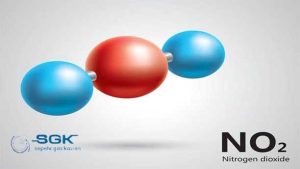Nitrogen dioxide gas
Nitrogen dioxide (NO2) is a reddish-brown gas with a pungent odor. It is one of the most common air pollutants and is formed when nitrogen oxides (NOx) react with other chemicals in the air.
Sepehr Gas Kavian Company is able to supply nitrogen dioxide gas in the following cylinders: 2 liter cylinder (150 bar), 5 liter cylinder (150 bar), 10 liter cylinder (150 bar), 20 liter cylinder (150 bar), 40 liter cylinder (150 bar), 50-liter cylinder (200 bar) with a purity percentage of 99.999% mol, 99.99% mol, 99.995% mol, 99.9999% mol (grade 4, 5, 5.5, 6).
For the first time in Iran, it is able to produce combined gases and gas mixtures with a percentage of either ppm or ppb of nitrogen dioxide.

Resources
The main sources of nitrogen dioxide gas are:
Power plants: Power plants that burn fossil fuels are the largest source of this gas emissions.
Transportation: Cars, trucks, and buses also emit Nitrogen dioxide gas, especially when they are idling or accelerating.
Industry: Industrial processes such as manufacturing, metal refining, and mining also emit NO2.
Natural sources: Lightning and some biological processes also produce Nitrogen dioxide.
Here are some specific resources of this gas:
Power plants: The combustion of fossil fuels in power plants is the largest source of this gas emissions. This is because the high temperatures and pressures of combustion reactions in power plants can cause nitrogen and oxygen to react to form Nitrogen dioxide.
Transportation: This gas emissions from transportation come from the combustion of fossil fuels in cars, trucks, buses, and other vehicles. The amount of this gas emitted from transportation depends on the type of fuel used, the engine efficiency, and the driving conditions.
Industry: This gas emissions from industry come from a variety of sources, including the production of nitric acid, the smelting of metals, and the combustion of fossil fuels in industrial boilers. The amount of this gas emitted from industry depends on the specific industrial processes involved.
Natural sources: This gas is also produced by natural sources, such as lightning and some biological processes. However, natural sources of Nitrogen dioxide gas are much smaller than human-caused sources.
Technical specification
| Chemical formula | NO2 |
| Molecular weight | 46.0055 g/mol |
| Boiling point | 21.1 °C (70.0 °F) |
| Melting point | -11.2 °C (11.8 °F) |
| Specific gravity | 1.25 (air = 1) |
| Vapor pressure | 25.8 kPa at 20 °C |
| Flammability limits | 3.5% – 50% |
| Odor | Strong, pungent odor |

Application
Nitrogen dioxide has a variety of applications, including:
Production of nitric acid: Nitric acid is an important industrial chemical that is used in the production of fertilizers, explosives, and other chemicals. This gas is a key intermediate in the production of nitric acid.
Vulcanization of rubber: Vulcanization is a process that is used to make rubber more durable and resistant to heat and chemicals. This gas is used in the vulcanization of rubber because it reacts with rubber to form a cross-linked network that makes the rubber stronger.
Manufacturing of dyes: This gas is used in the manufacturing of a variety of dyes. It reacts with other chemicals to produce dyes that are used in textiles, plastics, and other products.
Propellant in aerosol cans: Nitrogen dioxide gas is used as a propellant in some aerosol cans. It is a non-flammable gas that can be used to propel liquids out of cans.
Chemical synthesis: This gas is used in a variety of chemical synthesis reactions. It reacts with other chemicals to produce a variety of products, including drugs, plastics, and other chemicals.

Danger
This gas is a respiratory irritant and can cause a variety of health problems, including:
Short-term exposure: Coughing, shortness of breath, wheezing, and chest pain.
Long-term exposure: Chronic bronchitis, asthma, and decreased lung function.
Very high exposure: Death.
This gas can also damage plants and ecosystems. It can cause leaves to turn brown and fall off trees, and it can also damage crops.
Here are some of the dangers of nitrogen dioxide gas:
Fire and explosion: This gas is highly flammable and can easily ignite, causing a fire or explosion. This can happen if NO2 is exposed to heat, open flames, or sparks.
Asphyxiation: This gas is heavier than air, so it can displace oxygen in enclosed spaces. This can lead to asphyxiation, which is a lack of oxygen that can cause unconsciousness and death.
Skin burns: Liquid NO2 can cause frostbite if it comes into contact with the skin.
Eye irritation: This gas can irritate the eyes and cause redness, swelling, and watering.
Headaches and dizziness: Breathing in high concentrations of this gas can cause headaches, dizziness, and nausea.
Long-term health effects: Long-term exposure to this gas can increase the risk of cancer.





